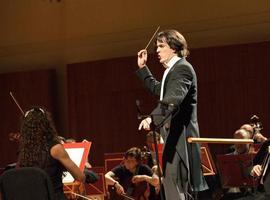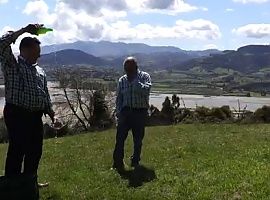Moscú/Ria Novosti.-Un equipo de negociadores de la Organización para la Seguridad y la Cooperación en Europa (OSCE) partió a Ucrania para contribuir a la liberación de los observadores militares de esta organización detenidos en Slaviansk, Ucrania, según una fuente del Gobierno alemán citada por Reuters.
“Ya están de camino”, dijo la fuente sin detallar cuántas personas integran la delegación ni el trayecto de su viaje.
La víspera, el “alcalde popular” de Slaviansk, Viacheslav Ponomariov, declaró que las milicias populares de esa ciudad del este de Ucrania detuvieron un autobús con representantes de la OSCE que viajaban acompañados por oficiales del Ejército ucraniano.
Más tarde, Denis Pushilin, copresidente del Gobierno provisional de la autoproclamada República Popular de Donetsk, dijo que los milicianos de Slaviansk creen haber atrapado a “espías de la OTAN” y quieren canjearlos por los suyos, incluido el “gobernador popular” de Donetsk, Pável Gúbarev.
FOTO: Observadores de la OSCE preparan su viaje en Kiev (OSCE)
Comunicado de la OSCE (en inglés)
Western and Central Ukraine, including Kyiv, as well the southern part of the country, remained calm. The situation continued to be tense in Luhansk region and particularly tense in Donetsk region. The Special Monitoring Mission got confirmation that the military observers carrying out an inspection under the OSCE Vienna Document had been taken captive by forces of the self-proclaimed mayor of Sloviansk.
Police presence in Kharkiv was notably reduced as compared to previous days. The Regional Administration building was guarded by about ten police officers in riot gear. The team went to Izium, close to the administrative border between the Kharkiv and Donetsk regions. The head of the Regional Administration in the city complained about the increase of police and military forces in the area. On the way back to Kharkiv the team saw seven additional military vehicles with armed personnel and communication equipment heading to Izium.
In Luhansk, the team observed reinforcement with barbed wire of the barricade in front of the occupied state security service (SBU) building, despite alleged ongoing negotiations reported in the media to vacate the building. The monitors were approached by one of the occupiers, who invited them to witness the release of a young supporter of a unitary Ukraine. The young man had a bruise under his left eye and a bloody nose. He was forced to read a statement to the media, and allowed afterwards to leave the SBU building area with his mother.
In addition, the team patrolled the vicinity of the Ukrainian-Russian border in the southeast part of the Luhansk region in the morning. Very good visibility and open terrain in various places made it possible to see a wide area. No military activity was observed during the patrolling. Border crossing between Ukraine and Russia appeared to be routine.
The overall situation within the Donetsk region remained tense, with many administrative buildings continuing to be occupied by opponents of the government and many roadblocks manned by unarmed or armed supporters of the so-called “Donetsk People’s Republic”. Barricades remained both around the Donetsk City Administration and Donetsk Regional Administration buildings. There was no indication that any of the floors of the latter had been returned. During the afternoon the team observed enhanced suspicion and alert on the part of Ukrainian police, especially at check points in the immediate aftermath of the abduction of members of the unarmed OSCE military verification mission in Sloviansk. The City Administration Building in Mariupol (113 km south of Donetsk) remained occupied.
In Sloviansk, the barricades on the outskirt of the city were manned with less people than in previous days and access to the city was uninterrupted. The team heard reports that no administrative services were being provided by the local administration.
The general situation remained largely unchanged in Dnepropetrovsk, Kherson, Mykolaiv, and the surrounding areas and was assessed as calm. The Kherson team went to Mykolaiv to discuss with the local rabbi the situation after the firebombing incident against the local synagogue on 19 April 2014. The rabbi expressed his view that a thorough police investigation had not been carried out. According to the rabbi, another incident had occurred– hate messages were painted on a Shoah memorial with paint spray on 24 April in the outskirts of Mykolaiv.
The situation in the Odessa region was marked by an explosion on the night of 24 to 25 April at the roadside checkpoint named “the 7th Kilometer”. Six Self-Defence volunteers and one Ukrainian policeman were injured. At the reporting time the police investigation of the incident was still ongoing.
The situation remained calm in Chernivtsi, Ivano-Frankivsk and Lviv region. However, the appointment of the new head of local administration in Kolomyia (60 km north of Ivano-Frankivsk) provoked protests by the Right Sector and Self-Defence, with 100 protestors blocking the local administration building. The protestors, which were unarmed and mostly dressed in camouflage with Right Sector flags, prevented some local officials from entering their workplaces. In Lviv, local authorities increased police presence and check points in and around the city as well as in the region in anticipation of May holiday. Local government authorities issued statements urging people not to join mass protests in order not to provide with arguments to opponents of unitary Ukrainian state. The representatives of the Right Sector in Lviv also called for calm.
The capital city was calm. The Kyiv Maidan was cleaner than the previous day. The team observed the ongoing refurbishment of the Kyiv City Administration’s building. The team made demarches in order to visit Pavlo Hubariev (in Russian: Pavel Gubariev), a self-proclaimed governor of Donetsk region, detained since 6 March.




















